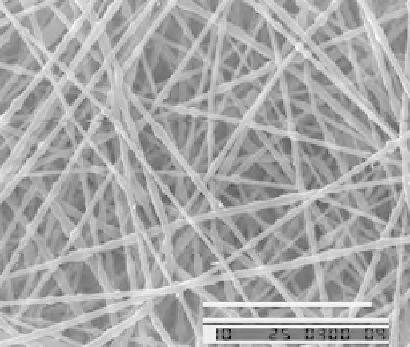Biomedical Engineering Reference
In-Depth Information
Fig. 8 SEM image of
electrospun PET nanofibers
containing 37.5% (w/w) of
MIP-E2 nanoparticles. The
scale bar is 10
m
m (adapted
with permission from [
111
]).
presence of structural analogues present in excess. In the SPE extraction of cos-
metic samples spiked with bisphenol A, MIP nanoparticles performed better than
commercial silica materials. The same group also synthesized 300-400 nm
core-shell MIP NPs for SPE of the herbicide metsulfuron-methyl (MSM) [
115
].
A MIP layer was thermally grafted to silica cores modified with an acryloyl silane.
The optimized MIP NPs had a maximum adsorption capacity 3.4 times higher than
non-imprinted particles and 3.8 times higher than conventional C
18
silica. In
addition, rapid rebinding kinetics could be obtained. In the SPE extraction of
samples of soil or from crops spiked with the template and its structural analogues,
MIP nanoparticles allowed the pre-concentration of MSM to a much higher level
than commercial silica or non-imprinted nanoparticles, thus allowing the subsequent
HPLC quantification to be performed with minimal noise. In a similar way Gao and
coauthors prepared core-shell nanoparticles imprinted with sulfamethoxazole
(SMO) to be used in SPE applications [
116
]. The MIP NPs specifically rebound
three times more SMO than bulk MIP or non-imprinted NPs, reaching the adsorp-
tion equilibrium in about 45 min. In the SPE pre-concentration of samples of eggs
and milk spiked with sulfonamides, the recoveries ranged from 73 to 89% with
relative standard deviations below 7.5%, allowing detection of SMO and of another
structural analogue, sulfadiazine, by HPLC analysis of the concentrates. Shamsipur
and coauthors prepared MIP NPs for copper ion using an anthraquinone derivative
as the specific complexing monomer [
37
]. MIP nanoparticles of 60-100 nm diame-
ter were prepared by precipitation polymerization. Under optimized adsorption
conditions MIP NPs exhibited a binding capacity of 73.8
mol g
1
and very good
selectivity in the presence of other ions. MIP NPs could be reused for at least 20
consecutive times, without any loss of affinity. Furthermore, when tested with well
and tap water samples spiked with Cu
2+
, MIP nanoparticles recovered 95-105% of
the ions present. Prasada Rao and coauthors prepared core-shell MIP NPs
imprinted with uranyl ions [
117
]. The authors first prepared functionalized silica
cores bearing an amino silane for the immobilization of quinoline-8-ol to improve
the specific interaction with the uranyl ions. A polymeric shell was formed
by precipitation polymerization, giving rise to MIP NPs of 50-80 nm diameter.
m

Search WWH ::

Custom Search